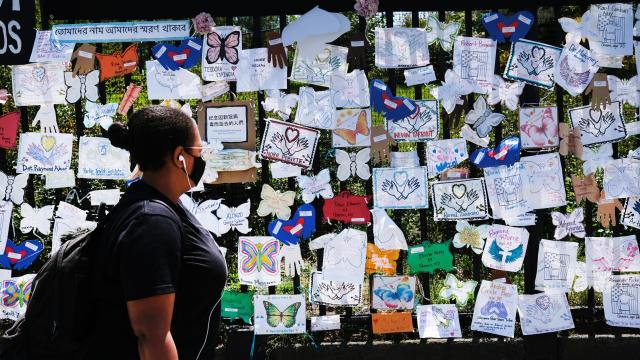The number of our fellow Americans lost to the novel coronavirus pandemic soared into the six figures on Wednesday afternoon, with the updated tally on the Johns Hopkins School of Medicine tracker now listing 100,396 confirmed deaths across the country.
The Census Bureau places the U.S.’s share of world population at around 4.3 per cent. The updated coronavirus tallies place the U.S. at over 28 per cent of the 355,575 deaths confirmed worldwide from the virus, and at 1,699,000 confirmed cases, at just under 30 per cent of the confirmed world total of 5,690,000.
It’s likely that that these numbers are undercounts and the U.S. quietly slid past 100,000 deaths some time ago. Dr. Anthony Fauci, the director of the National Institute of Allergy and Infectious Diseases and the nation’s leading infectious disease expert, until April 6.
Donald Trump, who has consistently downplayed the grave impact of the coronavirus and pushed scientifically unproven medical solutions to the crisis, claimed the U.S. was on track for 60,000 deaths as recently as mid-April and insisted the country was “going to be, hopefully, far below” 100,000 deaths on April 24.
Punting responsibility for dealing with the virus to state and local authorities has been a hallmark of his administration’s response, with key players like the Centres for Disease Control and Prevention sidelined and Trump insisting on a swift end to lockdown measures even as the White House plan for an expanded national testing program shifts much of the burden to states. A Columbia University study found that if social distancing measures had begun one week earlier than when they generally began in mid-March, the death toll would be 36,000 fewer. If those measures had been implemented two weeks earlier on March 1, per the New York Times, some 83 per cent of the deaths so far may have been avoided.
So last year 37,000 Americans died from the common Flu. It averages between 27,000 and 70,000 per year. Nothing is shut down, life & the economy go on. At this moment there are 546 confirmed cases of CoronaVirus, with 22 deaths. Think about that!
— Donald J. Trump (@realDonaldTrump) March 9, 2020
While the number of new cases nationally has slowed, much of that is due to a reduced number of cases in regions like New York that experienced massive outbreaks. The virus is still picking up steam in at least 13 states and rates of new infections are more or less holding steady in at least 21 others, with 16 states and D.C. seeing reductions, according to Vox. However, many states and localities are beginning to lift orders shutting down businesses and governments, and most of the states facing upticks in cases were among the first to reopen.
That’s raised the prospect a second surge of cases in the U.S. could happen as soon as this summer, rather than fall or winter. According to NPR, public health experts have warned that the death toll by August could exceed their prior estimates of 140,000.
“Now we’re almost getting the worst of both worlds — we’re getting the economic hardship and we’re relaxing,” Institute for Health Metrics and Evaluation at the University of Washington director Christopher Murray told the broadcaster. “And it seems either now or in the fall, we’re going to have a big second wave, and we’ll be right back to dealing with pressure on the hospital system and dealing with, when is the peak surge coming?”
The crisis has also undoubtedly worsened social and economic inequity throughout the country. The unemployment rate could break 20 per cent in May, by the admission of the White House, and according to NPR, CDC statistics accounting for the first 69,000 deaths have shown a massive disparity in which demographics have been hardest hit. Around 80 per cent of known deaths were individuals aged 65 or older, while among those under 75, twice as many males than females have died. Racial disparities are also clear, per NPR. Alabama is 27 per cent black, but black people comprised 44 per cent of counted deaths. In Michigan, those respective numbers were 14 per cent and 40 per cent.
Arizona is just five per cent Native American, but they accounted for 17 per cent of deaths there, NPR wrote.
“Back in March, I did not think this would be possible — I was not expecting 100,000 deaths,” Murray told NPR. “I really believed we as a nation would have taken the decision to put in place social distancing and accepted the economic hardship that it’s creating, and that we would have stuck to it to get transmission down to a very low level.”
Even if a vaccine is developed, which in a best case scenario won’t be until much later this year and is likelier to take around a year and a half, experts told the Washington Post the coronavirus is likely to become endemic.
“What’s concerning is that I don’t see any signs the federal government has learned any lessons and is doing anything differently to prepare for the next waves,” Columbia University’ National Centre for Disaster Preparedness director Irwin Redlener told the Post.
